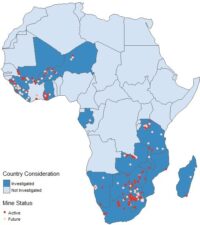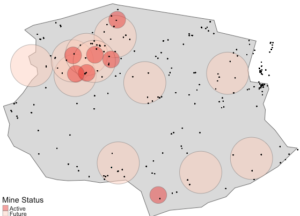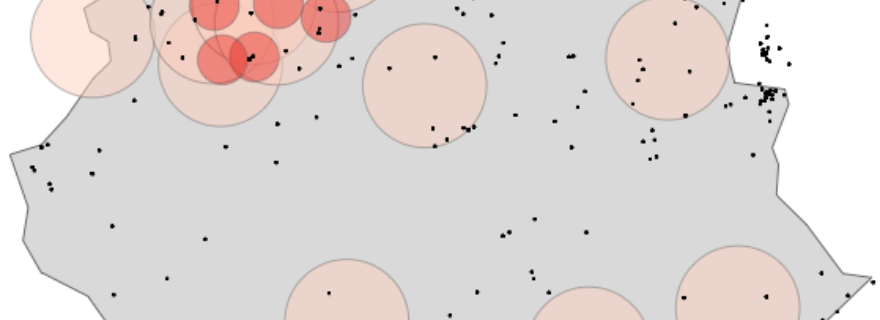Is Mineral Extraction Really That Bad for Local Communities?
Mining activities have attracted foreign investment to African countries for decades. Its supporters say that mining encourages economic growth, while its detractors argue that this comes at the cost of local communities.
My recent study published in Development Southern Africa finds that the answer may lie somewhere in between.
I spent the first few years of my life surrounded by what I thought were beautiful yellow mountains, which I later learned were, in fact, radioactive mine dumps left over from Johannesburg’s gold rush. I’ve seen first-hand the devasting impact the extraction industry can have on local communities’ health and livelihoods. So when I began my university education and was told that the extractive industry—particularly mineral extraction—could be good for local communities, I couldn’t make sense of it.
This is why I decided to study it.
I analysed data from almost 4 800 households near 148 large-scale mines in 19 African countries to estimate the impact that living near a mine has on living conditions. The results of the analysis suggest that whether a local community lives near a mine doesn’t matter. Instead, country location and level of urbanisation is far more important for predicting living condition outcomes.
The Pros and Cons of Industrial Mining
Despite the African continent’s reputation for being economically underdeveloped, almost a third of the world’s mineral wealth is concentrated here. This contradiction has led many organisations, such as the World Bank and the African Union, to encourage governments to use mining as a tool for economic development.
At a local level, these organisations argue that industrial mining has positive outcomes for local communities. They highlight outreach programs implemented by mining firms, like new schools and clinics for local residents. They also point to new jobs created by the opening of mines and the associated increase in income.
However, there are concerns that exploiting mineral wealth is actually a resource curse and does not lead to improved development outcomes. South Africa, for example, is the world’s largest exporter of platinum, yet local communities surrounding the mines do not have access to basic services like clean water or sewage removal. One of these mines, Lonmin Platinum, reported record profits of almost $2 billion in November 2011. Eight months later, 34 of their workers were killed and a further 78 injured during wage disputes. They were demanding a salary of $1,200 a month.
Current literature finds evidence for both positive and negative outcomes for local communities, which is summarised in the table below. Generally speaking, reported positive impacts tend to originate from research conducted by the World Bank and independent researchers from developed countries. Conversely, reported negative impacts are largely found by human rights organisations and independent researchers from developing countries with large mining sectors.
Reported Positive Impacts |
Reported Negative Impacts |
Creates local backward linkages (i.e. connections between mines and suppliers) |
Worsened inequality and poverty rates |
Increased income for locals |
Higher unemployment rates |
Increased consumption |
Increased food insecurity |
Improved literacy rates |
Increased pollution leading to worsened health outcomes |
Lower child mortality rates |
Destruction of local ecosystems |
Improved access to development infrastructure |
Increased civil unrest |
Table 1. Summary of common reported impacts of large-scale mining on local communities
Operationalising Living Conditions
Measuring living conditions in the African context is challenging for several reasons:
- Western-centric measures like income do not account for the informal nature of many African economies, such as bartering or access to public goods.
- Data availability in Africa is famously low—you may be well accustomed to a large grey area in the middle of most world data maps.
- Some high-quality datasets are behind paywalls, presenting a challenge for universities who do not have the budget for such research.
Because of this, I set out to define living conditions using freely available Afrobarometer opinion survey data.
I used 3 proxy indicators to measure living conditions, each comprising of several questions from the Afrobarometer surveys:
- Lived Poverty Index (LPI): How frequently respondents have gone without food, cooking fuel, clean water, medical care and cash income within the last year.
- Household Infrastructure Index (HII): Access to household amenities, including the quality of the respondent’s shelter, access to water, sanitation and electricity.
- Development Infrastructure Index (DII): The presence of piped water, an electric grid, a sewage system, a school and a clinic within the census enumeration area.
Using Afrobarometer data means that this research can be reproduced and repeated over time by anyone with access to a computer.


Results
To figure out how mines affect local communities in Africa, I used a similar strategy to previous research. If a respondent lived within 50km of a mine that was in production, they were labelled active (the treatment group). Respondents who lived between 50.1km-100km from a mine in production, or within 50km of a mine in the feasibility, advanced exploration or development stage were labelled as future (the control group).
I then measured how HII, DII and LPI are impacted by distance from a mine (mine proximity), controlling attributes of the country the respondent lives in, and whether the respondent lives in an urban or rural area.
The results did not show any relationship between mine proximity and living condition outcomes. Instead, the results suggest that respondents living in an urban area are more likely to enjoy access to both development and household infrastructure. While large-scale mining can lead to urbanisation, in developing countries, mining-induced urbanisation does not lead to industrialisation, and any positive impacts on infrastructure access reverses after the mine’s closure. Mining-induced urbanisation also leads to greater poverty and inequality than urbanisation by other means. Thus exploring more effective and long-term approaches to urbanisation may be preferable.


The results also suggest a weak positive relationship between GDP per capita and lived poverty, with much of the variation in the model coming from country effects. Countries which performed best on the Mineral Governance Barometer’s community impact measure also scored the best on LPI and DII. The mirroring of these results may mean that positive outcomes for local communities are primarily a function of state capacity, accountability, and regulation, rather than large-scale mining itself.
This study used a new methodology using freely available data in the hopes that future researchers will employ similar replicable quantitative methods. As such, the results discussed here have a few important caveats:
- The research only used one round of Afrobarometer surveys. More accurate results can be obtained by comparing respondents in the same sample areas over several years.
- Government quality was not included as a control variable, which is an important factor in analysing living condition outcomes. This research found a weak positive relationship between lived poverty and GDP per capita, but this was not explored further. Future studies should examine the link between GDP per capita and lived poverty for local communities in developing countries. This is especially important since countries with large extractive industries often have higher GDP per capita rates than their counterparts.
The lack of evidence for either a resource curse or blessing highlights the needs for further large-scale quantitative studies in this field. Current research on the effects of large-scale mining on local communities is mixed, which may reflect the smaller scale, qualitative nature of the bulk of current literature. Given international organisations’ tendency to apply sweeping development policies across the continent despite local nuances, cross-country replicable studies over time may provide valuable insights for policy makers.
This post is based on the research conducted by Lauren Veckranges at the University of the Witwatersrand. You can read the peer-reviewed paper, Estimating the impact of large-scale mining on local communities in sub-Saharan Africa, in Development Southern Africa.

